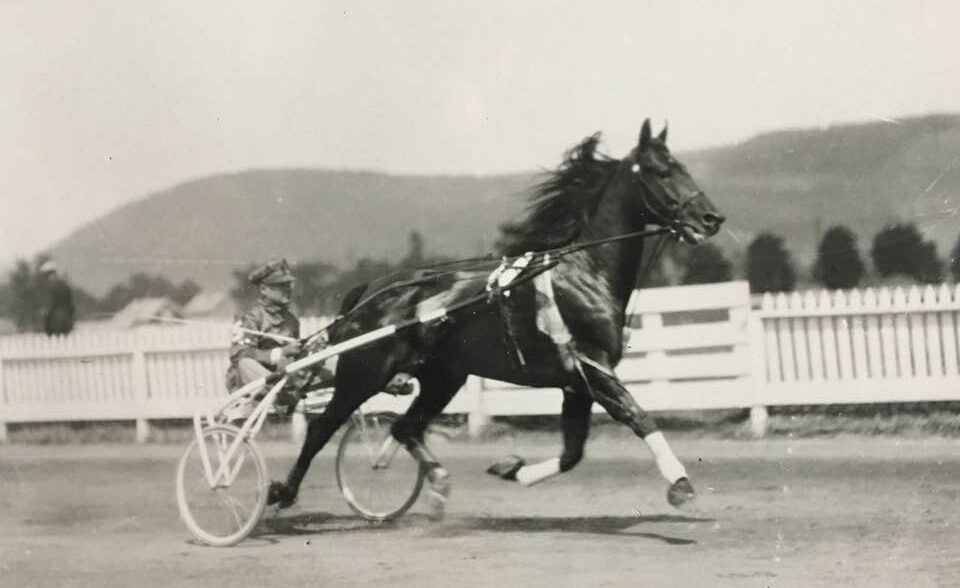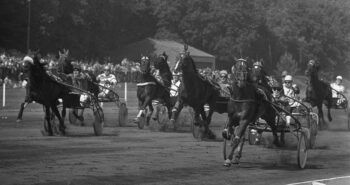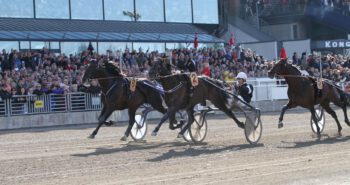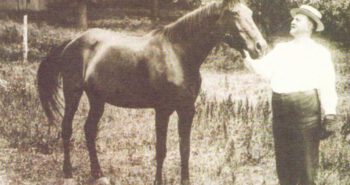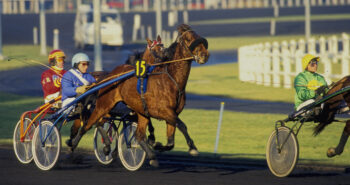He may just be the American horse imported to Europe who has left the biggest and most impressive stamp on trotting history. He was dominant on the track and despite relatively few foals left a lasting legacy. There was only one drawback with Sam Williams: he didn’t like the hill at Vincennes. That is a minor thing in the big picture, though, considering his massive influence on European trotting.
There is a lot of firsts in the story of Sam Williams. Born 1922, the colt was the first horse ever bred by WH Cane, the owner of Good Time Stables and Good Time Park. A winner of the 1924 Junior Kentucky Futurity, he made $8,520 at 2. At 3 he won the Matron and Horseman Futurity, winning the latter after a slow first half turned into a frenzied speed duel with Aileen Guy, a 1:07 first half being followed by 1:01 1/4, the last quarter completed in 29 1/4. Aileen Guy got her revenge in the four-heat Horse Review Futurity at Columbus, the first three heats being won by Aileen Guy, Guy Ozark and Sam respectively, before Aileen winning the race-off but needing to trot in 28 1/4 in the last quarter to hold off Sam Williams. His heat win in 2:04 3/4 (1.17,5) was the season mark for colts, while Aileen Guy took the season mark for fillies when she won both heats of the American Horse Breeder Futurity in 2:03 1/2 (1.16,8).
Aileen Guy also won the Kentucky Futurity with Sam Williams placing third but his $10,446 earnings made him the season’s leader for age, gait and sex. It is interesting to read an article in the Cincinnati Enquirer from Sept 13, 1925, which says “Sam Williams is a lot better colt than he has been given credit for being: a colt with perfect manners, about as much speed as any three-year old racing, and he can go about as far as any of them. When he was a two-year old he was accused by some of being “soft” but his races this season prove to the contrary.”
As the colt was broken it wasn’t immediately obvious the son of Peter Scott was a future star. An article in the Cincinnati Enquirer on Jul 31, 1927, stated that “Sam Williams is about as perfect mannered trotter as there is racing, but it was not always thus, according to his trainer. Cox says that when he first took him up as a two-year-old he was about as tough a customer as he ever handled, and he had handled a lot of them, including many of the Peter the Great youngsters when he was head trainer at Laurel Hall, any many of those Peter the Greats were terrors to break. According to Cox, the assistant trainers of the Good Time Stable, after a trial or two, were entirely willing that the boss man should have entire charge of Sam’s education, for the colt was as liable to take them for a trip through the center field as he was to stick to the track. Once broken, however, he stayed that way and he always has, since he first raced as a two-year-old, been a model of deportment on the track.”
Dominating on the Grand Circuit
As mentioned above, Sam Williams was the highest earner at both 2 and 3 in his crop and earned $40,184 in the US before being exported. Laid over at four due to illness, he returned in great style to be the dominant and leading aged stake trotter of 1927, winning nine of his ten starts on the Grand Circuit. The top win was probably the $10,000 Exchange Club Trot at Kalamazoo where he set his season best with a 2:02 1/4 (1.16,0) win. He also won $10,000 Empire State at Syracuse and the $5,000 Goshen Inn Stake at Good Time Park, as well as at Toledo, Detroit, North Randall (twice), Lexington (Castleton Stake) and Atlanta.
It is commonly believed that Sam Williams was bought by French interests around this time but this is actually not true. Rather, on June 17, 1928, it was announced in several newspapers that owner Cane had sold Sam Williams to George Tipling of Cleveland for $25,000. Tipling was later a director of the Hambletonian Society for 20 years and owned the 1953 Little Brown Jug winner Keystoner. Following the sale, Sam Williams was turned over to Charles Lacey, trainer for the Tipling stable. Sam Williams continued racing at six but had fewer opportunities than before, competing primarily against Guy Ozark, Kahla Dillon and, a couple of times, also his former stablemate from the Cane stable, Hazelton. In a time trial Sam trotted in 2:01 3/4 (1.15,7), his personal best. At the 43rd annual National Horse Show in Madison Square Garden in November, Sam Williams finished second in the class for trotters with a record of 2:10 (1.20,8) or better. Judging was based on conformation and racing qualities and Hazleton edged out Sam to win with Hollyrood Colin, owned by the Arden Homestead Stables, third.
An American in Paris
Lacking racing opportunities in the US, Tipling deciding to send his dark brown horse to Europe. Sam Williams was shipped on the steamer Minnetonka, leaving New York on Nov 9, shipping to Europe accompanied by Joe Haldeman of Malvern, Iowa, whom Tipling had contracted to train for him at the beginning of 1929. In France he was put in the training of Valentino Capovilla, best known as the trainer of the French super mare Uranie. Sam failed to adjust to the difficult Vincennes track whose uphill was steeper and was a lot more demanding back then than now. In the 1930 Prix d’Amerique, driven by Haldeman, who then became the first American to drive in the race, he finished sixth after initially leading but fading badly toward the end of the uphill. When passed by Amazone B, who would go on to win, and Uranie, Sam was already tired and eased up. Owner Tipling declared after the race that Sam had not been ready to enter the race but that he was entered only to please track officials and Capovilla. Still, Sam Williams was the first US-owned horse to start in the Prix d’Amerique, just as Haldeman was the first American to drive in the big race.
Sam Williams got some redemption the following weekend, finishing second in the Prix d’Belgique behind Bravade II. This was, however, the only top-3 placing Sam Williams would ever get against the best at Vincennes, and in the next race he failed to get any money in the Prix de Copenhague, won by Benjamin III.
As Sam struggled at the Vincennes track, Joe Haldeman didn’t fare much better in the French press. In the French daily L’Action française, they wrote (translated), “‘and he has a driver named Joë Haldeman, who has a special genius: he always positions his horse and sulky where there is no room to go.” Talk about a backhanded compliment…
A European superstar
At the beginning of February 1930, Tipling sold Sam to French owner Suzanne Villenave for $10,000. The high price looked like a bargain on March 5 when he set a new the track record at Enghien, the second racetrack in Paris. The flat Enghien track was much more suited to Sam. The old record being 1.21,8 (2:11.3), but Sam shattered it completely, establishing a new record at 1.19,6 (2:08). With Sam Williams being American, however, the new record was not entered in the record books and was thus unofficial. Realizing the Sam was not suited to Vincennes, Villenave sent his new star to top European trainer Charlie Mills in Berlin.
In Germany, the colt won on his debut on April 6. In the hands of the brilliant Mills, Sam Williams won 20 races around Europe in 1930. On the Ruhleben track in Berlin he trotted a kilometer (5/8 mile time) trial in 1.14.3 (1:59.3f) kilometer rate, a European record until bettered by Muscletone a few years later. At Vienna on Sep 30, Sam lost by the narrowest of margins to Hazleton in the Hunyady race, both trotters running 2575 meters in a kilometer time of 1.19,8 (2:08.2). He started a few times at Vincennes but they kept him away from the very best as he simply wasn’t good enough to beat them with the uphill. In 1932, for example, they skipped the Prix d’Amerique won by Hazleton, instead starting him in the Prix de Belgrade on Feb 11, 1932, when he finished second behind Epiminondas.
A spectacular stallion
Sam Williams entered stud in 1931 at his owner’s stud farm in Behoust just west of Paris, and had many sons at stud. Despite only 99 registered foals, the son of Peter Scott was a hugely influential stallion. In his second crop came the first standout, Lord Williams, who won the Criterium des 3 ans in 1936 and followed up by winning the Criterium des 4 ans in 1937. The follow season was Mauricio B and Mousko Williams. The latter was one of the top trotters in the 1934 crop and exceled both with and without a sulky. He was second in the Criterium des 4 ans in 1938 and repeated that feat in the monte/RUS group 1-races Prix de Vincennes in 1937 and Prix de President de la Republique the year after. The best 1935 foal was Notre Williams, was the son who did the best in aged races. The colt was third in the 1942 Prix d’Amerique. The follow year he was second in the Prix de Cornulier, France’s biggest monte/RUS race, before he won that race in 1944. Worth a mention is also Quick Williams, winner of the Criterium des 5 ans in 1943 and Uncle Williams, born 1942, who went to Italy and won Gran Premio Duomo in 1949.
His long-term impact is primarily through his son Mousko Williams. Mousko had many sons who excelled at stud, but two stood out; the first is Horus L who almost established a longtime sireline through the excellent Tony M, and the second is through Carioca II. Carioca II is extremely influential and was active through several sons. Through Carioca II the sireline extends to Coktail Jet and his son Love You and many sons of these two. It can also be added that French legend Ourasi is linebred 3×4 on Carioca II.
What if…?
It’s interesting to wonder what would happen if Sam Williams had been born a year later. Then he might not have been exported at all. The Hambletonian, with its big purse, was first run in 1926 with a purse of over $70,000. In 1925, when Sam Williams was three-years-old no race had that kind of the prize money. He was the winningest of his crop both as a 2 and 3 year old and would have been one of the favorites had there been a 1925 Hambletonian. He had won that hypothetical race the colt would probably have become a very popular stallion in the USA, and it is then quite likely that no sale would have taken place later … but that is just speculation anyway.
The history could have been very different in a third way, though. On Oct 17, 1929, Italian newspaper La Stampa reported that “Sam Williams is the 11th new American trotter purchased by the Mr Riva. He is the son of Peter Scott and Blitzie. San Williams is expected in Milan and will be given, like the rest of his stable, to Finn.” In the above “Mr Riva” and “Finn” refers to the wealthy Gianni Riva and trainer and driver Alexander Finn, famous and owner-trainer pair of double Prix d’Amerique-winner Muscletone.

The supposed sale to Italy wasn’t reported in the US, though, so it may very well be that Riva, or an Italian journalist, simply jumped the gun. Or maybe they simply misunderstood? In the Boston Globe on Nov 4, 1929, it said that Sam Williams “will race in Italy this winter. The son of Peter Scott and Blitzie has not been sold, but his owner, George Tipling of Cleveland, is going to travel abroad and plans a bit of diversion.” It’s not easy to know what to make of such little information close to 100 years later, but it clearly shows there was Italian interest in Sam Williams before he ended up in France.
Sam Williams died of natural causes in 1942 at his owner’s castle in Behoust, slightly less than one hour west of Paris.
Sam Williams
Brown colt born in Goshen, NY in 1922. Died in Behoust, France in 1942.
Peter Scott – Blitzie (Walnut Hall)
T2:01 3/4 (1.15,7)
Breeder: Good Time Stables
Owners: Good Time Stables – George Tipling – Suzanne Villenave
Trainers: Walter Cox, Charles Lacey, Joe Haldeman, Valentino Capovilla and Charlie Mills
Drivers: Walter Cox, Charles Lacey, Joe Haldeman, Valentino Capovilla and Charlie Mills
Grooms: Joe Haldeman and others

